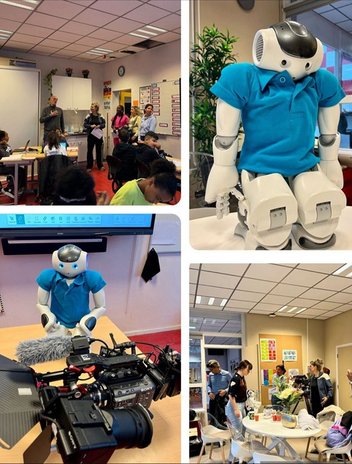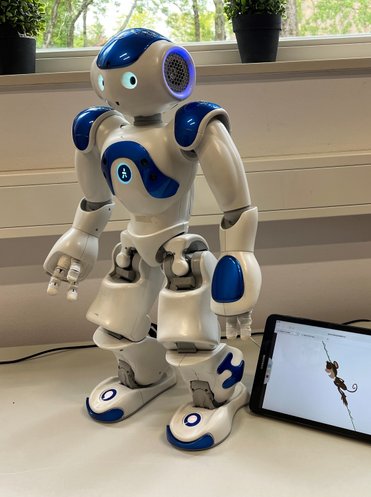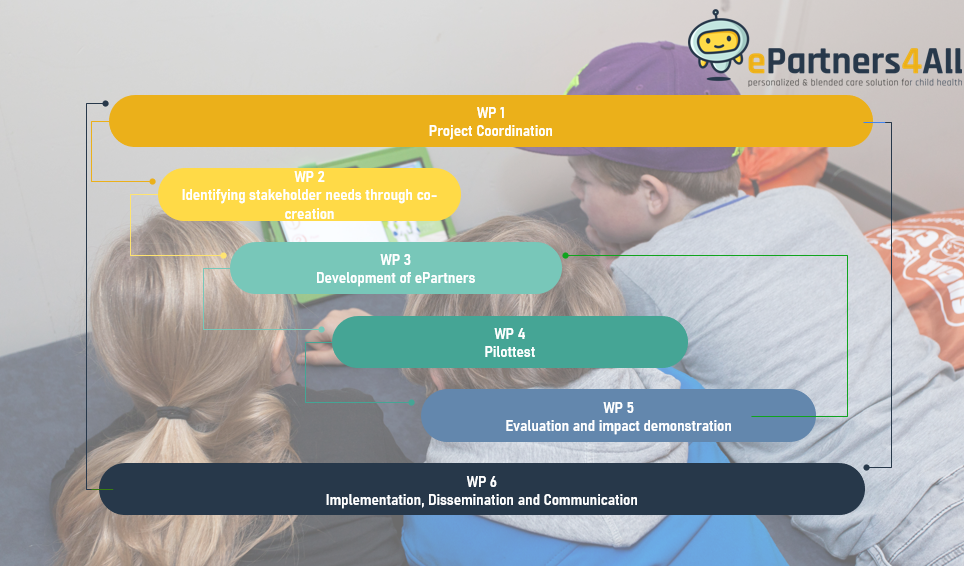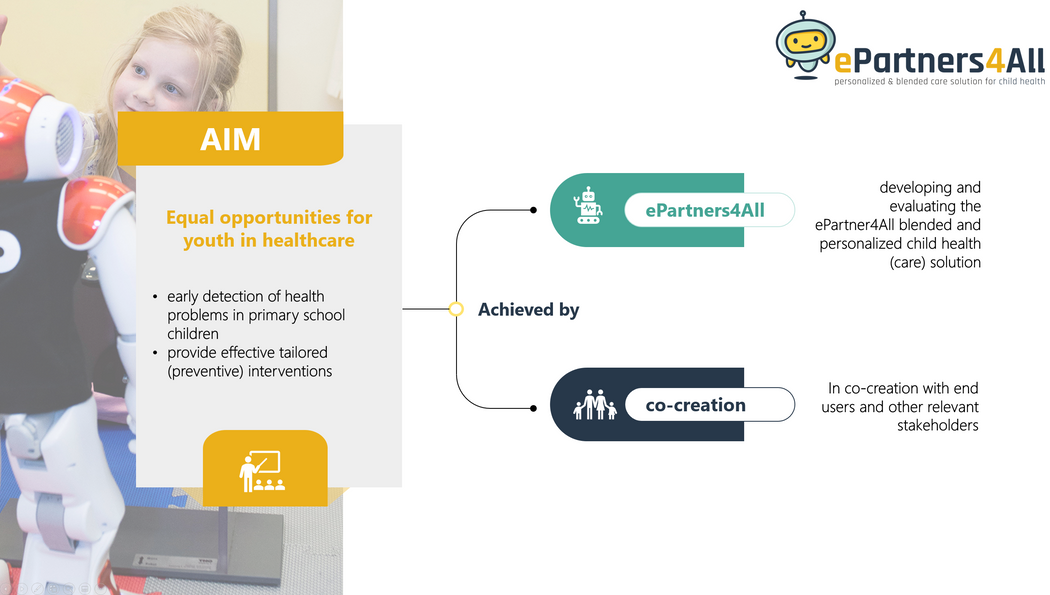ROBOT SUPPORTS THE WELLBEING OF CHILDREN
Children increasingly struggle with their psychosocial development. Therefore, a Dutch-Swiss consortium of public and private parties developed and evaluated ePartners4All, a blended care solution with a robot buddy to support the wellbeing of children in primary schools in the Netherlands and Switzerland. The Dutch TV show “het Klokhuis” has dedicated an episode to how AI can contribute to child-robot interaction. This episode was partly recorded during the ePartners4all evaluation. It airs 28 March 2024 and can be viewed via this link: https://hetklokhuis.nl/dossier/168/het-klokhuis-over-ai/tv-uitzending/5397/ai-gedrag
E-Health solutions may be effective for health promotion in children, but often reach only a part of the target group. The objective of ePartners4all was to create equal opportunities for all children through a combination of personal and digital support. Professionals, parents, and children each have their own ePartner, including a dashboard for the professional and a robot buddy for children. ePartners4All was developed in co-creation with these end-users and other stakeholders, such as parents.
ePartners4All: working together to improve wellbeing at school
With ePartners4All, through the dashboard, teachers and parents set goals for the children related to self-esteem, self-image or behaving in social settings. After this, the teacher and child set tasks to achieve these goals. Finally, the children performed the tasks with the robot, such as looking at and discussing educational video’s together and making matching assignments. The assumption is that through these tasks with the robot, children develop skills contributing to wellbeing at school.
Results of the pilot study
The current pilot studies primarily investigated the feasibility, acceptability, and usability of a robot-delivered mental health-promoting intervention within a primary school setting. The studies were conducted in the Netherlands and Switzerland following a comparable protocol.
The results from the Dutch pilot study show that the intervention was in generally perceived as moderately feasible and acceptable according to both teachers and children, although several challenges were identified with the implementation and integration of the intervention into the school setting. More specifically, teachers were not always able to find the time to select the most suitable themes for the children, or to consult with the child about which sessions within these themes he/she would be best suited to attend. Furthermore, addressing children’s questions regarding the content of the intervention sessions, as well as the amount of learning required to determine suitable intervention themes for the children, required a substantial time investment by the teachers. Despite these challenges, children were very enthusiastic about the robot and teachers generally reported they would like to use the intervention more often in the school setting.
The Swiss pilot study revealed that the children enjoyed working with the robot, they had the impression that they have learned something from the intervention, and they would like to use the robot in future. Teachers reported that children would have liked more interaction with the robot and that the tasks tended to be too easy. Major shortcomings were related to the technology. For the study in Switzerland the language capability of the robot with respect to speaking in German was insufficient and the device was technically not stability enough. The technical challenges required a high amount of support. In summary, the Swiss pilot study showed that the acceptability of using a robot was clearly given, but feasibility and usability need to be improved to allow routine application in school.
To summarize, two pilot studies were conducted as part of the ePartners4all project, using a robot in school settings, that provided an intervention aimed at promoting child wellbeing. Evaluation feedback from both teachers and children highlight the potential for future implementation, but that in order to realize this potential, is it essential to address several identified areas for improvement.
The future of robots supporting the health and well-being of children
Our evaluation shows that using a dashboard and robot to deliver a mental health-promoting intervention to primary school children is feasible and acceptable. However, the robot intervention can be improved in several ways. For example, the robot requires a stable internet connection, and the audio-input of the robot should be improved so that it can understand children’s voices better. Furthermore, the robot would work better, if it was able to understand gestures of children (such as head nodding for “yes” and shaking the head for “no”), if the robot could provide more personal feedback, and if large language models were integrated in the robot, the conversation between robot and children could potentially be more fluent. The ePartners4all project partners continue to develop innovations to improve the robot-child interaction so that in the future, robots can support the health and wellbeing of all children.
Testimonial
Robots do not judge and provide a safe environment for learning. Research shows that children often bond with a robot buddy.
Marx Neerincx, professor of Human-centered Computing at TNO and TU Delft
About the project
Project overview and objectives
E-Health solutions may be effective for health promotion in children, but often reach only a part of the target group. Our objective is to create equal opportunities for all children through ePartners4All, a personalized blended care solution. We will develop and evaluate the ePartner4All system in co-creation with end-users. There is a large challenge to advance the physical and mental health of children, especially in groups with low economic status and children with special needs or specific health problems. Approximately 145000 children in the Netherlands have disabilities in communicative and social-emotional skills. There is a workforce shortage of physicians, nurses and teachers. Schools have a tight school curriculum with very limited space for additional support to children. There is hardly any sharing of information between schools and preventive youth healthcare services, and limited availability and fragmentation of personalized interventions. In this project we take digital support of school-aged children and their caregivers a big leap forward, by not only monitoring their health, but also providing interactive e-health solutions (so-called ePartners), including robot buddies and virtual agents that enhance children’s health and well-being. A needs assessment, ePartners4All development, and pilot study will be performed in co-creation with end-users. These ePartners can help to prevent health problems in at-risk children, and it can help to recognize and treat health problems at an early-stage, thereby preventing deterioration of the problem. In this way, ePartners4All can help to create a more resilient society. Altogether, it could lead to lower healthcare utilization and, in the long-run, a more resilient workforce with lower losses of productivity. The deliverables of our project are a needs assessment, the ePartners4all platform, results of the pilot-evaluation and lessons learned. After the project, our partners will embed ePartners4all within their own applications, and/or offer licensed services via the platform.







